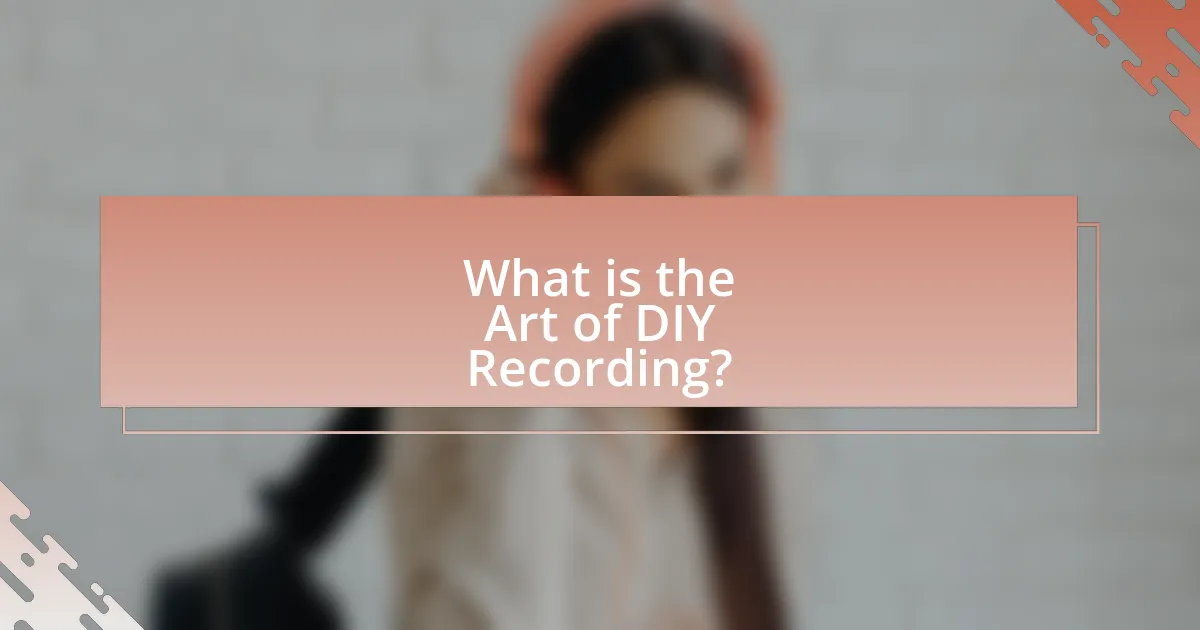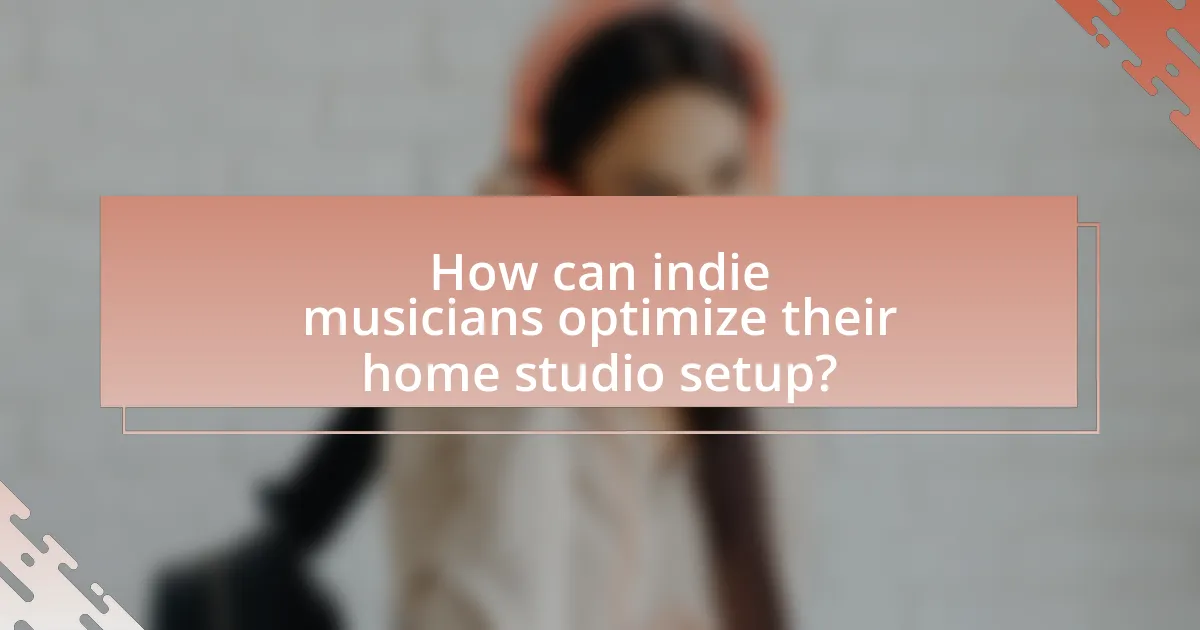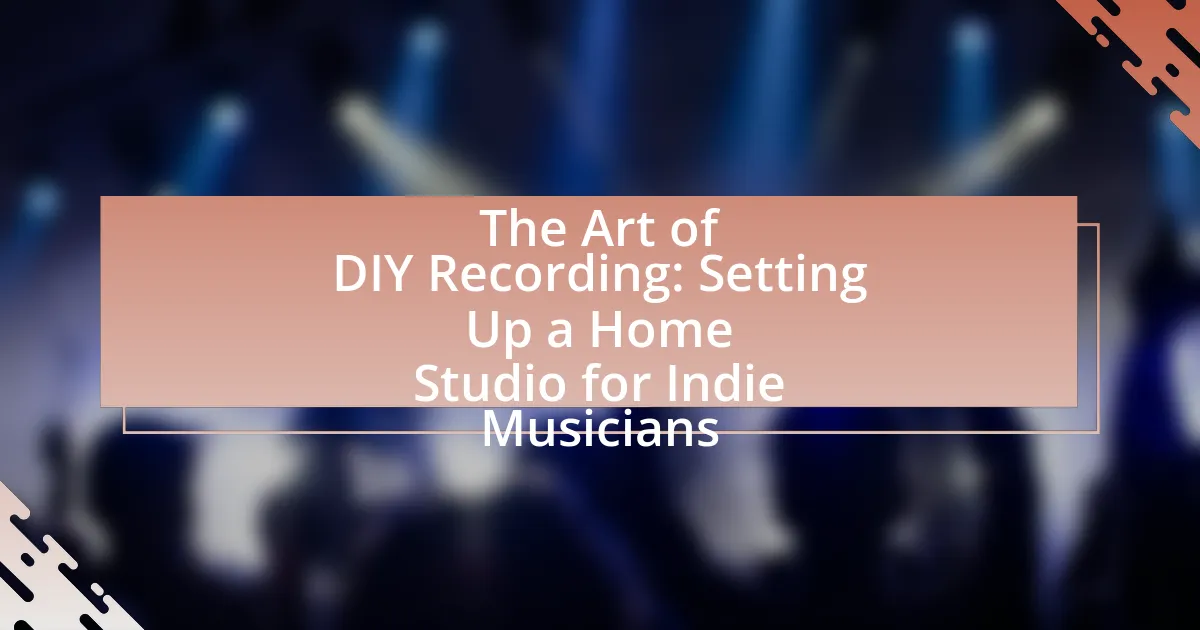The Art of DIY Recording focuses on the independent creation of high-quality audio recordings by musicians using accessible tools and techniques. This practice allows artists to maintain creative control and save costs by setting up home studios, which have become increasingly feasible due to affordable recording equipment and software. The article explores the differences between DIY and professional studio recording, the advantages and challenges faced by indie musicians, and the essential components needed for a home studio setup. It also discusses the importance of acoustic treatment, effective organization, and common pitfalls to avoid, providing valuable insights for musicians looking to optimize their recording process and enhance their production quality.

What is the Art of DIY Recording?
The Art of DIY Recording refers to the practice of independently creating high-quality audio recordings using accessible tools and techniques. This approach empowers musicians to produce their own music without relying on professional studios, allowing for greater creative control and cost savings. The rise of affordable recording equipment and software has made it feasible for indie musicians to set up home studios, enabling them to experiment with sound and production methods. According to a report by the International Federation of the Phonographic Industry, the growth of home recording has significantly contributed to the diversification of music genres and the emergence of new artists in the industry.
How does DIY recording differ from professional studio recording?
DIY recording primarily differs from professional studio recording in terms of equipment quality, expertise, and production environment. In DIY recording, musicians typically use consumer-grade equipment and software, which may limit sound quality and production capabilities. In contrast, professional studios are equipped with high-end microphones, mixing consoles, and acoustic treatment, ensuring superior audio fidelity. Additionally, professional studios often employ experienced sound engineers who provide technical expertise and creative input, enhancing the overall production quality. This difference in resources and expertise significantly impacts the final sound and production value of the recordings.
What are the key advantages of DIY recording for indie musicians?
The key advantages of DIY recording for indie musicians include cost savings, creative control, and flexibility. Cost savings arise from eliminating studio fees, allowing musicians to allocate resources to other aspects of their projects. Creative control enables artists to make artistic decisions without external influence, fostering a more authentic sound. Flexibility allows musicians to record at their own pace and schedule, accommodating personal and professional commitments. These advantages empower indie musicians to produce high-quality music while maintaining their artistic vision and financial independence.
What challenges do indie musicians face in DIY recording?
Indie musicians face several challenges in DIY recording, including limited access to professional equipment, lack of technical expertise, and difficulties in achieving high sound quality. Limited access to professional-grade microphones, audio interfaces, and software can hinder the recording process, as many indie musicians may rely on budget-friendly alternatives that do not deliver the same quality. Additionally, without formal training in audio engineering, musicians often struggle with mixing and mastering, which are crucial for producing polished tracks. A study by the Berklee College of Music highlights that 70% of independent artists report feeling overwhelmed by the technical aspects of recording, further emphasizing the need for both resources and knowledge in the DIY recording landscape.
Why is setting up a home studio important for indie musicians?
Setting up a home studio is important for indie musicians because it provides them with the ability to create, record, and produce music on their own terms. This autonomy allows musicians to experiment with their sound without the constraints of a commercial studio, leading to greater artistic freedom. Additionally, having a home studio significantly reduces recording costs, as musicians can avoid expensive hourly rates typically charged by professional studios. According to a survey by the Music Industry Research Association, 70% of independent artists reported that home recording has enabled them to produce higher quality music at a fraction of the cost. This accessibility empowers indie musicians to take control of their creative process and reach their audience more effectively.
How can a home studio enhance the creative process?
A home studio enhances the creative process by providing a dedicated space for musicians to experiment and produce without external distractions. This controlled environment allows for immediate access to recording equipment, fostering spontaneity and creativity. Studies show that having a personalized workspace can increase productivity and motivation, as individuals feel more comfortable and inspired in their own settings. Furthermore, the ability to record ideas instantly helps capture fleeting moments of inspiration, which is crucial for the creative flow in music production.
What impact does a home studio have on production quality?
A home studio significantly enhances production quality by providing musicians with control over their recording environment and access to professional-grade equipment. This control allows for tailored acoustics, which can reduce unwanted noise and improve sound clarity. Studies indicate that artists who utilize home studios often achieve a sound quality comparable to that of commercial studios, as they can invest in high-quality microphones, audio interfaces, and software. Furthermore, the convenience of a home studio enables musicians to experiment and refine their sound without the pressure of time constraints typically found in professional settings.

What are the essential components of a home studio?
The essential components of a home studio include a computer, audio interface, microphones, studio monitors, headphones, and digital audio workstation (DAW) software. A computer serves as the central hub for recording and editing audio, while an audio interface converts analog signals to digital for processing. Microphones capture sound, and studio monitors provide accurate playback for mixing. Headphones are crucial for monitoring audio without bleed, and DAW software enables recording, editing, and producing music. These components collectively facilitate a functional and effective home recording environment for indie musicians.
What equipment is necessary for a basic home studio setup?
A basic home studio setup requires a computer, audio interface, microphone, headphones, and digital audio workstation (DAW) software. The computer serves as the central hub for recording and editing audio. An audio interface converts analog signals from the microphone into digital data for the computer, ensuring high-quality sound capture. A microphone is essential for recording vocals and instruments, while headphones allow for accurate monitoring of audio without feedback. DAW software provides the platform for recording, editing, and mixing audio tracks, making it a crucial component of the setup. These elements collectively enable indie musicians to produce professional-quality recordings from home.
What role does an audio interface play in recording?
An audio interface serves as a crucial component in recording by converting analog audio signals into digital data that a computer can process. This conversion allows musicians to capture high-quality sound from instruments and microphones, ensuring fidelity in recordings. Additionally, audio interfaces often provide preamps, which amplify weak signals from microphones, and offer various input and output options for connecting multiple devices. The quality of the audio interface directly impacts the clarity and detail of the recorded sound, making it essential for achieving professional results in home studio setups.
How do microphones differ in their applications for recording?
Microphones differ in their applications for recording primarily based on their design and intended use, which affects their sensitivity, frequency response, and pickup patterns. Dynamic microphones are commonly used for live performances and loud sound sources due to their durability and ability to handle high sound pressure levels, while condenser microphones are preferred for studio recordings because of their sensitivity and wider frequency response, capturing more detail in vocals and acoustic instruments. Additionally, ribbon microphones, known for their warm sound, are often used in studio settings for vocals and brass instruments, providing a unique tonal quality. Each type of microphone serves specific recording needs, making the choice crucial for achieving desired audio quality in various recording environments.
What software options are available for DIY recording?
Several software options are available for DIY recording, including Digital Audio Workstations (DAWs) like Audacity, GarageBand, FL Studio, Ableton Live, and Pro Tools. Audacity is a free, open-source software that supports multi-track recording and editing, making it accessible for beginners. GarageBand, available on macOS and iOS, offers a user-friendly interface and a variety of virtual instruments. FL Studio is known for its loop-based production and is popular among electronic music producers. Ableton Live provides a unique session view for live performances and is favored by electronic musicians. Pro Tools is a professional-grade software widely used in the industry, offering advanced editing and mixing capabilities. These options cater to various skill levels and recording needs, making them suitable for indie musicians setting up a home studio.
What are the differences between digital audio workstations (DAWs)?
Digital audio workstations (DAWs) differ primarily in their features, user interfaces, and intended use cases. For instance, some DAWs like Ableton Live are optimized for live performance and electronic music production, while others like Pro Tools are favored for professional audio editing and mixing in studio environments. Additionally, DAWs such as FL Studio offer a more intuitive interface for beginners, whereas Logic Pro provides advanced tools for music composition and production. These differences are reflected in their pricing models, compatibility with plugins, and the range of built-in instruments and effects they offer, catering to various user needs and preferences in the music production process.
How can plugins enhance the recording process?
Plugins can enhance the recording process by providing a wide range of audio effects and tools that improve sound quality and creativity. These software components allow musicians to apply equalization, compression, reverb, and other effects in real-time, enabling precise control over the audio mix. For instance, using a compressor plugin can help manage dynamic range, ensuring that quieter sounds are audible while preventing distortion from louder signals. Additionally, plugins can simulate high-end studio equipment, making professional-grade sound accessible to indie musicians without the need for expensive hardware. This versatility and affordability make plugins essential for enhancing the overall recording experience.

How can indie musicians optimize their home studio setup?
Indie musicians can optimize their home studio setup by investing in quality audio interfaces, acoustic treatment, and essential recording software. Quality audio interfaces enhance sound capture and playback, ensuring clarity and fidelity in recordings. Acoustic treatment, such as foam panels and bass traps, minimizes unwanted reflections and improves the overall sound quality within the recording space. Essential recording software, like Digital Audio Workstations (DAWs), provides the necessary tools for editing, mixing, and producing music efficiently. According to a survey by Sound on Sound, 70% of home studio owners reported that acoustic treatment significantly improved their recording quality, validating the importance of these optimizations.
What are the best practices for acoustic treatment in a home studio?
The best practices for acoustic treatment in a home studio include using bass traps, acoustic panels, and diffusers to manage sound reflections and improve overall sound quality. Bass traps, typically placed in corners, absorb low frequencies, reducing muddiness in recordings. Acoustic panels, mounted on walls, help to absorb mid and high frequencies, minimizing echoes and flutter. Diffusers scatter sound waves, preventing harsh reflections and creating a more balanced sound environment. Research indicates that proper acoustic treatment can enhance recording clarity and accuracy, making it essential for achieving professional-quality results in home studios.
How can soundproofing improve recording quality?
Soundproofing can significantly improve recording quality by minimizing external noise interference and controlling sound reflections within the recording space. By using soundproofing materials such as acoustic panels, bass traps, and soundproof curtains, the recording environment becomes more isolated, allowing for clearer and more accurate sound capture. Studies have shown that reducing ambient noise levels can enhance the signal-to-noise ratio, which is crucial for achieving professional-grade recordings. For instance, a well-soundproofed room can reduce noise levels by up to 30 decibels, leading to a cleaner audio output that is free from unwanted background sounds.
What materials are effective for acoustic panels?
Effective materials for acoustic panels include fiberglass, foam, and mineral wool. Fiberglass panels are known for their high sound absorption capabilities, often used in professional studios due to their efficiency in reducing mid to high-frequency sounds. Acoustic foam, typically made from polyurethane, is lightweight and effective for controlling echoes and reverberation, making it popular in home studios. Mineral wool, or rock wool, offers excellent sound absorption and fire resistance, making it suitable for both acoustic treatment and safety. These materials are widely recognized in the industry for their effectiveness in enhancing sound quality in recording environments.
How can musicians effectively organize their recording space?
Musicians can effectively organize their recording space by implementing a structured layout that maximizes functionality and minimizes clutter. This involves designating specific areas for instruments, recording equipment, and mixing, ensuring that each component is easily accessible. For instance, placing frequently used gear within arm’s reach can enhance workflow efficiency. Additionally, utilizing storage solutions like racks, shelves, and bins can help keep cables and accessories organized, reducing the risk of tangling and damage. Studies show that a well-organized workspace can lead to increased productivity and creativity, as it allows musicians to focus on their craft without distractions.
What layout considerations should be made for a home studio?
A home studio layout should prioritize sound isolation, equipment accessibility, and workflow efficiency. Sound isolation can be achieved by placing the studio in a quiet area of the home, using soundproofing materials, and ensuring that walls and windows minimize external noise. Equipment accessibility involves organizing instruments, microphones, and recording devices within easy reach to facilitate a smooth recording process. Workflow efficiency can be enhanced by arranging the space to allow for a logical flow between different tasks, such as recording, mixing, and editing. These considerations are essential for creating a functional and effective home studio environment.
How can cable management improve workflow in a studio?
Cable management can significantly improve workflow in a studio by reducing clutter and enhancing organization. When cables are neatly arranged, it minimizes the risk of tangling and tripping hazards, allowing musicians and engineers to move freely and focus on their tasks. Efficient cable management also facilitates quick access to equipment, which is crucial during recording sessions where time is often limited. Studies have shown that organized workspaces can increase productivity by up to 20%, highlighting the importance of a tidy environment in creative settings.
What common mistakes should be avoided in DIY recording?
Common mistakes to avoid in DIY recording include inadequate room treatment, poor microphone placement, and neglecting to monitor levels. Inadequate room treatment can lead to unwanted reflections and background noise, negatively affecting sound quality. Poor microphone placement can result in imbalanced recordings, as positioning affects the capture of sound sources. Neglecting to monitor levels can cause distortion or clipping, which compromises audio integrity. These mistakes are frequently observed among indie musicians setting up home studios, emphasizing the importance of proper acoustics, strategic mic positioning, and careful level management for achieving professional-sounding recordings.
How can poor mic placement affect recording quality?
Poor mic placement can significantly degrade recording quality by introducing unwanted noise, altering frequency response, and affecting the overall balance of sound. When a microphone is positioned too far from the sound source, it captures ambient noise and reverberation, which can muddy the recording. Conversely, placing the mic too close can lead to distortion and an exaggerated bass response, known as the proximity effect. Studies show that optimal mic placement can enhance clarity and detail, while poor placement can result in recordings that lack definition and presence. For instance, the Audio Engineering Society emphasizes that proper positioning can improve signal-to-noise ratio, thereby enhancing the overall fidelity of the recording.
What are the pitfalls of neglecting room acoustics?
Neglecting room acoustics can lead to poor sound quality and ineffective recording environments. When room acoustics are not considered, sound waves can reflect off hard surfaces, causing echoes and reverberation that distort audio clarity. This distortion can result in recordings that sound unprofessional and lack detail, making it difficult for musicians to achieve the desired sound. Additionally, improper acoustics can mask certain frequencies, leading to an imbalanced mix where some instruments or vocals are either too prominent or too subdued. Studies have shown that untreated rooms can introduce significant coloration to sound, which can hinder the mixing and mastering process, ultimately affecting the final product’s quality.
What tips can help indie musicians succeed in DIY recording?
Indie musicians can succeed in DIY recording by investing in quality equipment, learning basic recording techniques, and utilizing software effectively. Quality microphones and audio interfaces enhance sound capture, while understanding gain staging and mixing principles ensures a polished final product. Additionally, using digital audio workstations (DAWs) like Ableton Live or Pro Tools allows for versatile editing and production capabilities. Research indicates that musicians who engage in continuous learning and experimentation with their setup achieve better results, as they adapt their techniques to suit their unique sound.
How can musicians develop their recording skills over time?
Musicians can develop their recording skills over time by consistently practicing recording techniques, experimenting with different equipment, and seeking feedback on their recordings. Regular practice allows musicians to become familiar with their recording software and hardware, enhancing their technical proficiency. Experimenting with various microphones, interfaces, and recording environments helps musicians understand how different setups affect sound quality. Additionally, obtaining constructive criticism from peers or mentors can provide valuable insights, enabling musicians to refine their skills and improve their recordings.
What resources are available for learning about DIY recording techniques?
Numerous resources are available for learning about DIY recording techniques, including online courses, video tutorials, books, and forums. Websites like Coursera and Udemy offer structured courses on recording techniques, while YouTube hosts countless tutorials from experienced musicians and sound engineers. Books such as “The Recording Engineer’s Handbook” by Bobby Owsinski provide in-depth knowledge on recording practices. Additionally, forums like Gearslutz and Reddit’s r/audioengineering allow users to share experiences and seek advice from the community, enhancing the learning process through peer interaction.


